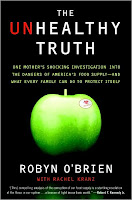From CNN (read the entire article and view a video here):
If you're eating non-organic celery today, you may be ingesting 67 pesticides with it, according to a new report from the Environmental Working Group.
The group, a nonprofit focused on public health, scoured nearly 100,000 produce pesticide reports from the U.S. Department of Agriculture and the U.S. Food and Drug Administration to determine what fruits and vegetables we eat have the highest, and lowest, amounts of chemical residue.
Most alarming are the fruits and vegetables dubbed the "Dirty Dozen," which contain 47 to 67 pesticides per serving. These foods are believed to be most susceptible because they have soft skin that tends to absorb more pesticides.
"It's critical people know what they are consuming," the Environmental Working Group's Amy Rosenthal said. "The list is based on pesticide tests conducted after the produce was washed with USDA high-power pressure water system. The numbers reflect the closest thing to what consumers are buying at the store."
The group suggests limiting consumption of pesticides by purchasing organic for the 12 fruits and vegetables.
"You can reduce your exposure to pesticides by up to 80 percent by buying the organic version of the Dirty Dozen," Rosenthal said.
The Dirty Dozen
Celery
Peaches
Strawberries
Apples
Domestic blueberries
Nectarines
Sweet bell peppers
Spinach, kale and collard greens
Cherries
Potatoes
Imported grapes
Lettuce
Not all non-organic fruits and vegetables have a high pesticide level. Some produce has a strong outer layer that provides a defense against pesticide contamination. The group found a number of non-organic fruits and vegetables dubbed the "Clean 15" that contained little to no pesticides.
The Clean 15
Onions
Avocados
Sweet corn
Pineapples
Mango
Sweet peas
Asparagus
Kiwi fruit
Cabbage
Eggplant
Cantaloupe
Watermelon
Grapefruit
Sweet potatoes
Sweet onions
Wednesday, June 2, 2010
Subscribe to:
Posts (Atom)


